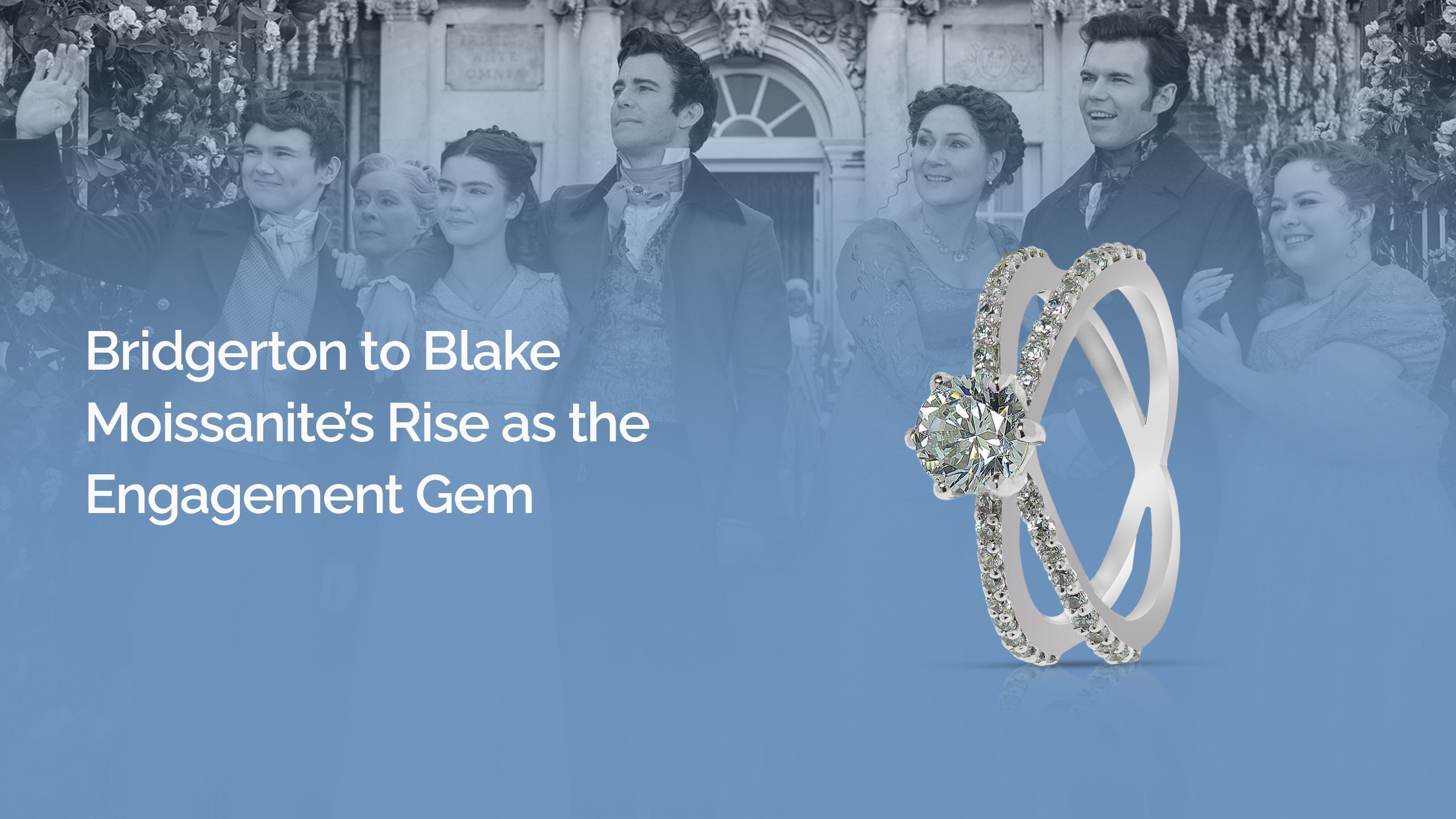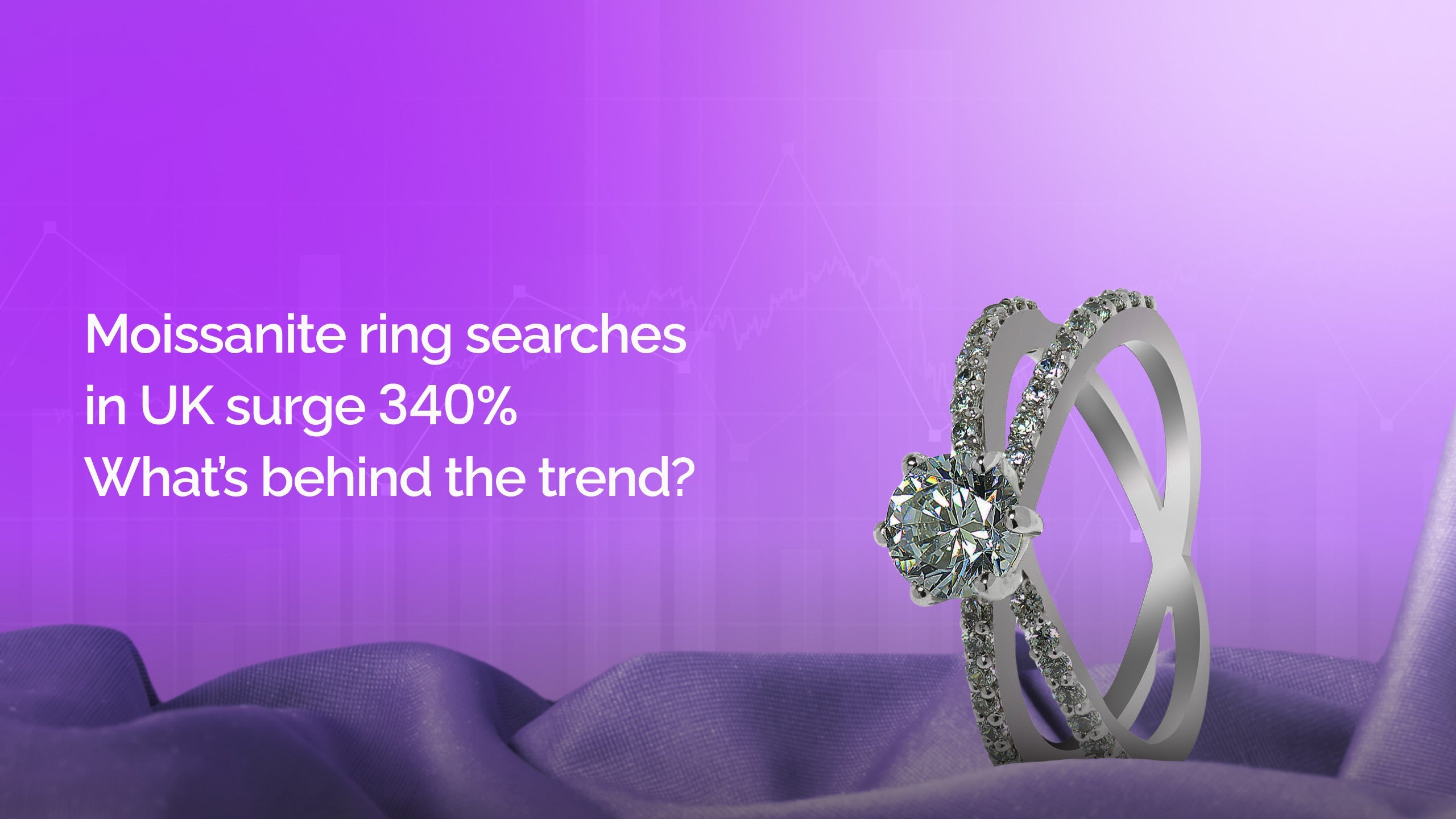News
From Bridgerton to Blake Lively: How Moissanite Became the Period-Drama Engagement Gem
When Netflix’s Bridgerton returned with its lavish third season, the show’s ripple effect went far beyond corsets and classical covers. It stirred a renewed obsession with historical romance—and unexpectedly, it brought Moissanite engagement rings into the limelight. A quick look at Google Trends shows a sharp spike in searches for “Regency dress” and “Moissanite engagement ring” across the UK in the weeks following the series premiere. While niche terms like “Moissanite filigree ring” and “Victorian-style Moissanite” generate low volume, trend curves suggest increased interest, particularly among younger buyers who are enchanted by ornate vintage aesthetics. But the story isn’t just in the numbers. On Reddit, users are sharing real-life purchases that mirror the fictional extravagance of Lady Whistledown’s world. One r/MoissaniteUK post reads: “I recreated Blake Lively’s oval-cut ring using a 3-carat Moissanite in rose gold. It’s dazzling and costs less than £500!” The comment section, with hundreds of replies, is filled with similar stories—people swapping diamonds for Moissanite while keeping the grandeur. This connection to celebrity isn’t coincidental. While Blake Lively’s ring features a blush-toned diamond, fans are replicating the look using Moissanite stones in elongated cuts. The appeal? High sparkle, ethical sourcing, and affordability—all while channelling Hollywood glamour. Quora threads echo the shift in mindset. One upvoted answer to “Why choose Moissanite over diamonds?” states: “Moissanite lets you have something ethical, eye-catching, and vintage-inspired without the price tag or environmental concerns.” These discussions reflect a broader generational trend: consumers are no longer just price-conscious—they’re purpose-conscious. Even professionals have weighed in. On LinkedIn, jewellery consultants and gemologists are directly linking Bridgerton’s aesthetics to the rising demand for Moissanite. A post from jewellery strategist Gaurav Jain reads: “Regencycore has reignited interest in silver-toned engagement stones. Moissanite’s brilliance plays perfectly with this vintage revival.” Jewellers themselves are adapting, showcasing a series of Bridgerton-inspired Moissanite rings alongside a caption celebrating the show’s romantic influence. This public pivot highlights a market that’s listening closely to pop culture—and responding in real time. The media don’t just drive the movement. Values reinforce it. Reddit and Quora users often cite Moissanite’s artificial origins and conflict-free status as key factors in their decision-making. One Reddit user wrote: “My fiancé loved the fact that it’s lab-created. It’s guilt-free sparkle with old-world charm.” While some critics once called Moissanite a “placeholder” or “fake diamond,” today’s buyers proudly showcase it as their first choice. With vintage-style settings, radiant cuts, and ornate bands, the ring becomes less about tradition and more about storytelling. As the cultural momentum behind period dramas continues and ethical buying gains ground, Moissanite isn’t just a trend. It’s becoming the symbol of a new kind of romance—one that balances timeless beauty with modern values. From Blake’s iconic ring to Bridgerton’s ballroom fantasies, Moissanite has found its moment. And for thousands of couples across the UK, that sparkle is more than enough to say yes.
🗓July 16, 2025
Moissanite Now Outselling Diamonds in UK Proposal Rings – New Data Reveals
In an unprecedented market shift, UK jewelers report that moissanite engagement rings have overtaken diamonds in sales—driven largely by cost-conscious Gen Z and millennial buyers. This first-of-its-kind trend signals a major disruption in a market long dominated by diamond tradition. Search Trends Show a Clear Shift Google Trends data reveals that searches for “moissanite engagement ring UK” have surged, with a 340% increase over the past 12 months—outpacing “diamond engagement ring” by a wide margin. The rise is especially pronounced in urban centres like London, Manchester, and Birmingham, where affordability and ethical sourcing are top priorities for younger couples. Real Voices from Online Forums Online forums reflect this shift in sentiment: On Reddit’s r/EngagementRings, users praise moissanite’s durability and sparkle: “Well-cut moissanite will shine, sparkle, and last a lifetime or longer… looks reminiscent of, though not identical to, a diamond.” On WeddingWire, a UK user adds:“Moissanite is hardy but does not perform or look like diamonds to anyone who is familiar with them.” These conversations reveal a growing acceptance that moissanite is not just a cheaper alternative—it’s a desirable stone in its own right. Ethics Over Tradition Produced in labs, moissanite avoids the environmental and human rights concerns often associated with diamond mining. According to consumer ethics organisations, many younger buyers now prioritise transparency, sustainability, and responsible sourcing when making high-value purchases—especially for emotionally significant items like engagement rings. Mindset of the Modern Buyer On the MoneySavingExpert forums, buyers frequently highlight the practical value of moissanite: “We opted for a moissanite ring and saved thousands compared to a conventional diamond.” Meanwhile, TikTok trends show increasing admiration for moissanite, with many viral videos featuring the stone as a “diamond dupe” that lets couples reallocate money toward housing deposits, travel, or savings—priorities frequently echoed by Gen Z. Industry & Retail Impact The moissanite surge is reaching brick-and-mortar stores. A LinkedIn industry report revealed that more than 2,000 UK jewellery retailers have now adopted moissanite testing equipment, reflecting real-world shifts in inventory planning. Retailers are also adapting their messaging. With Gen Z and millennials driving today’s luxury market, brands are increasingly promoting “ethical sparkle,” “handmade beauty,” and “smart luxury”—framing moissanite as a forward-thinking choice. Forecasts for 2025 point toward customizable ring designs, including bezel settings, mixed-metal bands, and three-stone arrangements. These emerging styles complement moissanite’s brilliance, affordability, and lab-based origin, making it an ideal fit for modern preferences. Moissanite’s combination of affordability, durability, ethical appeal, and visual brilliance has propelled it ahead of diamonds in the UK proposal ring space. As younger generations continue to favour smart, conscious purchases over tradition, this shift is likely to redefine jewellery trends for years to come. The industry is watching closely—and clearly, it’s beginning to follow.
🗓July 16, 2025
UK Jewellery Industry Pushes for Moissanite Certification Standards in 2025
LONDON, UK – July 2025 — As moissanite surges in popularity across the UK for its affordability, ethical appeal, and diamond-like sparkle, jewellers are increasingly calling for formal certification standards to regulate its sale and grading. Without industry-backed guidelines, consumers are left vulnerable to misrepresentation—particularly in online marketplaces, where moissanite is often mislabelled as a "lab diamond." Unlike diamonds, which benefit from globally recognised grading systems from institutions such as the Gemological Institute of America (GIA), moissanite remains unregulated. This lack of oversight has opened the door to inconsistent labelling, questionable certifications, and a general lack of transparency—an issue industry professionals believe is damaging trust within the market. Search Trends Reveal a Spike in Public Uncertainty Data from Google Trends shows a sharp rise in UK searches for terms such as "GRA moissanite fake", "moissanite certification", and "Is moissanite a real diamond?". The increase, observed between January and June 2025, underscores growing confusion around what moissanite is—and whether it's being marketed honestly. Reddit and Quora Users Voice Concerns That confusion is echoed across online forums where UK buyers seek clarity about their purchases. On Reddit's r/EngagementRingsUK, questions like "I was told this was a lab diamond, but now I'm not sure—how can I check if it's moissanite?" are becoming common. Similarly, Quora threads show UK-based shoppers are asking pointed questions such as: "How do I know if moissanite is real or fake?" "Is GRA a legitimate certificate for moissanite in the UK?" These platforms highlight a growing issue: without standardisation, buyers lack reliable tools for verification—and often only discover discrepancies after the purchase has been made. Jewellers Urge Regulatory Action Jewellery professionals across the UK are now calling on trade authorities and gemological institutions to introduce a clear, enforceable grading standard for moissanite. "Without clear moissanite standards, we're seeing a Wild West situation—some sellers market moissanite as a diamond alternative, others just label it 'lab diamond' outright," said a spokesperson from a London-based ethical jeweller. While some UK retailers rely on documentation from Charles & Colvard, one of the original commercial producers of moissanite, or the International Gemological Institute (IGI), these certificates are not universally recognised or regulated. More concerning is the widespread use of GRA certificates, which many Reddit and Quora users say are easily forged or unverifiable. A common sentiment across Reddit threads is that GRA documentation amounts to "just a sticker and a QR code with no database behind it." Proposals for Moissanite Grading Standards Industry leaders suggest that any official certification system should reflect moissanite's distinct optical properties—including its higher refractive index, double refraction, and unique colour dispersion—rather than mimic diamond grading verbatim. Suggested features of a new standard include: QR-verifiable grading reports UV watermarking Public-access gemstone databases "Moissanite deserves transparency—it's not a knockoff; it's a beautiful gem with its strengths," said one UK gemologist during a Reddit AMA. Next Steps: White Paper in Progress A white paper is currently being developed by a coalition of UK jewellers, aiming to promote the national-level adoption of certification standards and potential alignment with international grading laboratories. In the meantime, consumers are advised to: Request verifiable documentation Purchase from UK-based retailers with transparent policies Research thoroughly via trusted platforms like Reddit and Quora With the UK jewellery industry now actively leading the charge, 2025 could mark the beginning of a more transparent, trustworthy moissanite market—both domestically and globally.
🗓July 15, 2025
Fake Diamond Listings? UK Jewellers Warn Against Moissanite Mislabeling in Online Marketplaces
UK jewellers are warning consumers about a growing number of online listings that misrepresent moissanite as lab-grown diamonds. The alerts come amid rising reports of buyers receiving moissanite stones that were marketed as diamonds on platforms such as eBay, AliExpress, and unregulated online boutiques. Moissanite, a lab-created gemstone renowned for its exceptional brilliance and affordability, is gaining popularity in the UK. However, industry experts say the visual similarity between moissanite and diamond is being exploited by some sellers who intentionally mislabel products to command higher prices. The issue has gained traction as consumer confusion becomes more visible. Google Trends data shows a significant increase in UK-based search queries such as “moissanite vs diamond,” “Is moissanite fake,” and “moissanite engagement ring UK” over the first half of 2025. Source: Google Trends Concerns are echoed across online forums. On Reddit’s r/EngagementRingsUK, users have questioned the legitimacy of stones they believed to be diamonds but later suspected to be moissanite. “I was told this was a lab diamond, but now I’m not sure—how can I check if it’s moissanite?” one user posted. Source: Reddit Similar discussions are occurring on r/Moissanite, where users report stones failing thermal diamond testers—an issue consistent with moissanite’s different physical properties. Source: Reddit On Quora, UK users have raised questions about moissanite being marketed as lab-grown diamonds, with some reporting deceptive listings on sites that do not offer gemological certification. Source: Quora Industry professionals are now calling for regulatory intervention. Many are advocating for stricter guidelines requiring clear gemstone disclosure and mandatory third-party certification, such as from the Gemological Institute of America (GIA) or the International Gemological Institute (IGI), for all diamond and diamond-alternative sales. “There is currently no obligation for sellers to disclose the difference between moissanite and lab-grown diamonds, especially on global marketplaces,” said a spokesperson for a London-based jewellery retailer. “This lack of regulation creates a risk of consumer fraud.” Retailers have also urged online platforms to verify gem listings before publishing and to penalize vendors that repeatedly mislabel their products. While moissanite is a legitimate gemstone in its own right, its use as a stand-in for diamonds—without full disclosure—is seen as a growing threat to consumer trust in the jewellery market. The issue is further complicated by trends on social media platforms such as TikTok and Pinterest, where moissanite jewellery has been promoted widely for its affordability and sparkle. These posts often fail to clarify that moissanite is not a diamond, contributing to public misunderstanding. In response to the confusion, UK jewellers have begun launching consumer awareness campaigns focused on how to verify gemstones, read certificates, and use both thermal and electrical testers—since moissanite can mimic diamonds in some basic heat tests but not in electrical conductivity. Until comprehensive regulations are introduced, experts advise consumers to shop only with verified sellers, request lab reports for any stone advertised as a diamond, and treat any product listed without certification as potentially misrepresented. The Advertising Standards Authority (ASA) and Trading Standards have not yet issued formal guidance specific to moissanite labelling, but industry groups are expected to petition for legislative updates later this year.
🗓July 15, 2025
UK Searches for Moissanite Rings Surge by 340% in 12 Months – What’s Driving It?
LONDON — July 2025: Online searches for "moissanite rings" in the UK have surged by over 340% in the past year, according to Google Trends data, indicating a significant shift in consumer interest toward affordable and ethically sourced alternatives to mined diamonds. The rise is being attributed to a confluence of factors, including mounting cost-of-living pressures, increasing awareness of sustainable sourcing, and viral social media trends driven by celebrity influence. Rising Ethical Concerns Around Traditional Diamonds The UK jewellery market has witnessed a marked shift in consumer sentiment as awareness grows regarding the environmental and humanitarian impacts of diamond mining. Moissanite, an artificially created gemstone composed of silicon carbide, has emerged as a leading alternative to diamonds. Its manufacturing process avoids the environmental degradation and conflict associations tied to diamond extraction. "Consumers—especially younger demographics—are asking harder questions about where their jewellery comes from," said an analyst from Ethical Consumer UK. "Moissanite offers a transparent alternative." According to Deloitte's 2024 UK Gen Z & Millennial Survey, over 60% of these consumers now actively consider sustainability and social values before making a luxury purchase. Economic Conditions Driving Affordable Alternatives The moissanite boom also coincides with economic stress. As the UK continues to grapple with the effects of high inflation, stagnant wages, and elevated living costs, consumers are prioritising affordability without sacrificing aesthetics. Moissanite costs approximately 80–90% less than a mined diamond of equivalent visual size and quality. With jewellery classified as a discretionary purchase, this price difference has driven consumers to seek out lower-cost alternatives. "Jewellery purchases are increasingly about smart value," noted a market economist from the Centre for Retail Research. "Moissanite delivers that balance of quality and affordability that fits the current economic climate." Statista data shows that inflation is still affecting consumer purchasing patterns across both luxury and non-essential sectors. TikTok Influence and Celebrity-Inspired Designs Online platforms are also fueling the surge in interest in moissanite. Videos under the hashtag #MoissaniteRing have received over 400 million views on TikTok in the past 12 months, according to HypeAuditor's 2025 TikTok Trend Report. Popular videos often compare moissanite to diamonds, emphasising its comparable brilliance and affordability. This online momentum has been further amplified by consumer emulation of celebrity engagement rings—most notably, oval-cut styles similar to those worn by Blake Lively and Hailey Bieber. While these celebrities wear diamonds, their ring designs have influenced moissanite copycat versions that dominate UK online marketplaces and bridal forums. The Broader Shift Toward Sustainable Luxury Beyond individual purchasing decisions, the moissanite trend reflects a broader shift toward values-based luxury. A 2024 joint report by McKinsey and Business of Fashion found that 67% of Gen Z and Millennials are more likely to support brands that align with their personal ethics and environmental values (McKinsey, 2024). Experts believe the rise of moissanite may be part of a larger recalibration of luxury itself—moving away from exclusivity and toward transparency, accountability, and accessibility. What's Next With interest in moissanite rapidly growing, industry analysts predict increased adoption across mid-tier and high-end jewellery retailers. Some have called for clearer grading standards and better consumer education around moissanite's characteristics, especially as demand begins to rival that of lab-grown diamonds. As of July 2025, the UK jewellery sector is responding to a new kind of consumer: one who expects both sparkle and substance.
🗓July 14, 2025







